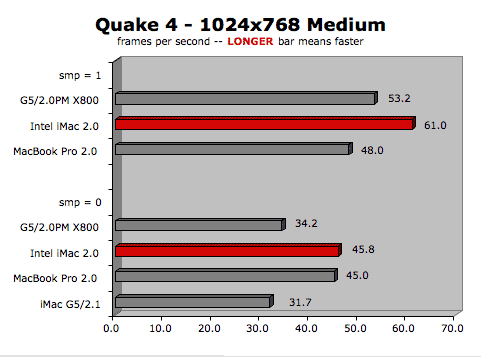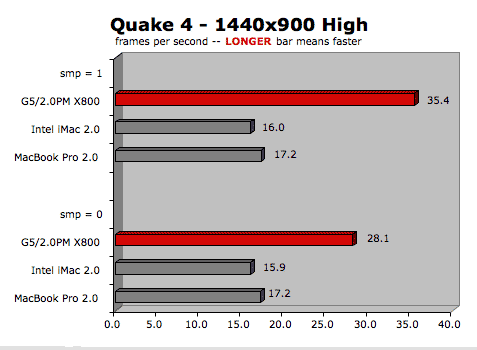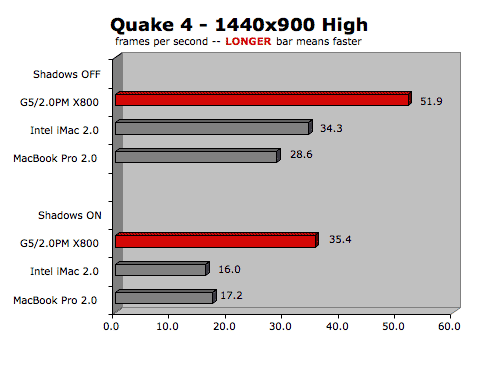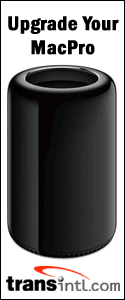
|
|
Originally posted May 9th, 2006, by rob-ART
morgan, mad scientist Aspyr released the 1.2 Patch yesterday that adds SMP (multi-processor) support to Quake 4 - Mac Edition. We tested Quake 4 using the "id_demo001" network timedemo on various Intel and PPC Macs running at around 2GHz to see how things shake out. Graph Legend: On the other hand, the G5 Power Mac (two processors running at the same 2GHz as the Intel Macs) with the ATI Radeon X800 XT saw a gain from having SMP enabled even at higher quality settings and higher resolutions (1440x900). Whether it's due to pixel rates or pipelines, the X1600 GPU in the Intel Macs obviously "hits the wall" sooner than the X800 XT. The SMP benefit at higher settings was also observed in our unpublished tests with the GeForce 6800 Ultra as well as our Quad-Core running the GeForce 7800 GT. FYI, the MacBook Pro's Radeon X1600 GPU has its core clock set to 311MHz while the Intel iMac's core clock is set to 405MHz. This difference must be to keep the MacBook Pro's internal temperatures at a tolerable level. In spite of that, the MacBook Pro beat the Intel iMac on the 1440x900 "High" test. It may have something to do with the fact that 1440x900 is the native resolution of our MacBook Pro. GAME ON, SHADOWS OFF MORE TO COME RELATED ARTICLES GeForce 7800 GS on a Single-Core G5/2.5MP Power Mac (AGP 8X) See how the Dual G5 and Quad G5 compare to the new Core Duo iMac when running games at 1680x1050 High Quality. WHERE TO ORDER YOUR APPLE PRODUCTS WHERE TO BUY VARIOUS GRAPHICS CARDS FOR YOUR POWER MAC and MAC PRO For your Mac Pro, you have the following 16X PCI Express (PCIe) options: If you didn't order the Radeon X1900 XT with your Mac Pro, you can order the Radeon X1900 XT as an aftermarket kit for your Mac Pro, go to the Apple Store and click on DISPLAYS in the left margin or do a search on "X1900." NOTE: Mac Pro PCIe graphics cards will not work in Power Mac G5s with PCIe slots -- and vice versa. Nor will Windows PC PCIe graphics cards work in the Mac Pro. Graphics Card Options for the Dual-Core or Quad-Core G5 with 16X PCI Express slot: It's also sold by Small Dog Electronics and Other World Computing. The following cards only work on a G5 Power Mac with 8X AGP slot: Apple's Online Store is no longer selling the GeForce 6800 GT or Ultra, which had Dual-Dual-Link DVI ports (for two 30" Cinemas). The "G5 only" Radeon 9800 Pro Mac Special Edition (8X AGP, 256MB, ADC + DVI port) is no longer made by ATI. The following cards work on both the G5 Power Mac (8X AGP) and G4 Power Macs with 2X or 4X AGP: ATI Online Store, Buy.com and Other World Computing have the Radeon 9600 Pro PC and Mac Edition (4X AGP, 256MB, DVI + Dual-Link DVI port) as well. It's compatible with late model G4 Power Macs and all G5 Power Macs with AGP slots. Priced at $199 MSRP it is the lowest priced AGP graphics card with Dual-Link DVI support. Has Bare Feats helped you? How about helping Bare Feats?
Quake 4 with SMP Patch
on various 2GHz Macs
G5/2.0PM X800 -- G5/2.0GHz Power Mac with Radeon X800 XT (256MB)
Intel iMac 2.0 -- Intel iMac Core Duo 2.0GHz with Radeon X1600 (256MB)
MacBook Pro 2.0 -- MacBook Pro Core Duo 2.0GHz with Radeon X1600 (256MB)
iMac G5/2.1 -- iMac G5/2.1GHz with Radeon X600 (128MB)
All test systems at 2GB of main memory
smp = 1 -- multiprocessor support enabled
smp = 0 -- multiprocessor support DISabled
Low -- Low quality with HQ Special Effects OFF and Shadows OFF
Medium -- Medium quality with HQ Special Effects ON and Shadows OFF
High -- High quality with HQ Special Effects ON and Shadows ON



INSIGHTS
The Intel Macs outperformed the G5/2.0 Power Mac with the Radeon X800 XT when Low and Medium settings were used. However, when we bumped things up to High quality with Shadows ON and SMP ON, they not only fell behind the G5 tower but they failed to benefit from SMP mode.
As with Doom 3, the most effective way to bump up your frame rates, assuming you prefer running at High Quality setting, is to turn off Shadows. Take a look at these numbers...
By the way, how would you like to have a Mac that runs Quake 4 at 65 fps even at 1440x900 High Quality with Shadows ON? Stay tuned for more on that.
When ordering products from Apple Store USA, please click THIS TEXT LINK or any Apple display ad as your "portal" to the online store. In so doing, you help to support Bare Feats.
The GeForce 7300 GT (16X, 256MB, dual-link DVI + single-link DVI port) is the default. We recommend the Radeon X1900 XT (16X, 512MB, two dual-link DVI ports) as a CTO option. It's much faster than the GeForce 7300 GT and just as fast as the expensive Quadro FX 4500. According to Alias/Autodesk, the X1900 XT is the only graphics card without limitations when using Maya 8.5. To custom order your Mac Pro with the Radeon X1900 XT, go to the Apple Store and click on the Mac Pro graphic.
The best option for your Dual-Core or Quad-Core G5 with PCIe slots is the ATI Radeon X1900 G5 Mac Edition released in November 2006. You can buy it directly from ATI's Online Store for $299 (with "trade up" allowance).
The "G5 only" Radeon X800 XT Mac Edition (8X AGP, 256MB, ADC + Dual-Link DVI port) is available from ATI Online Store, Apple's Online Store, Buy.com, Other World Computing, and Small Dog Electronics. (The MSRP is $299)
Other World Computing has the new ATI Radeon 9800 Pro Mac (2X/4X AGP, 256MB, DVI + VGA ports) graphics card in stock for $259. ATI has it on their Online Store for $249. The SKU number is 100-435058, in case you want to make sure you are getting the right card.
"BARE facts on Macintosh speed FEATS"
Email , the webmaster and mad scientist





